Contents
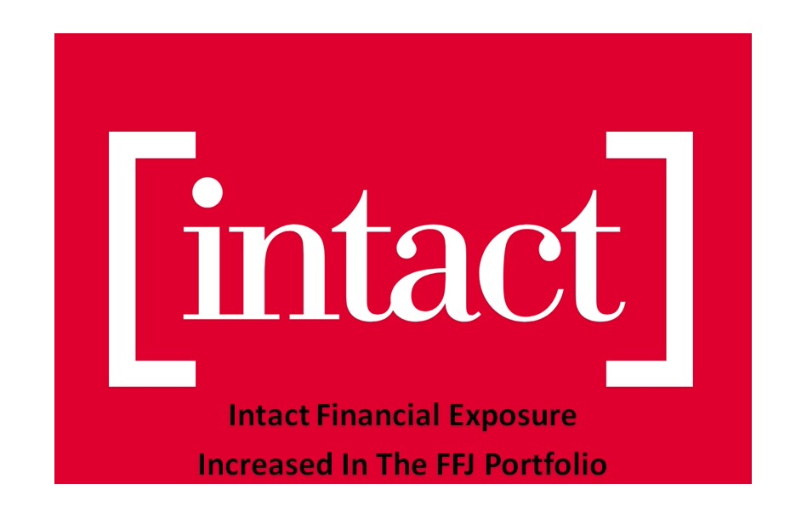
Despite being a loyal Canadian, I have very little desire to invest in Canadian companies. My reasoning is that I think I can generate superior long-term total investment returns from US companies. Secondly, most Canadian listed companies do not satisfy my risk tolerance. This is why I have made a conscious decision to limit my Canadian equity exposure to:
- Brookfield Asset Management (BAM.to)
- Brookfield Corporation (BN.to)
- Canadian National Railway (CNR.to)
- Canadian Pacific Kansas City (CP.to)
- Intact Financial (IFC.to)
- The Royal Bank of Canada (RY.to)
Having said this, my combined Brookfield Asset Management and Brookfield Corporation exposure represented my 15th largest holding when I completed my 2025 Mid-Year Portfolio Review. Intact Financial was my 28th largest holding.
I pay very little attention to some of my Canadian holdings. My June 2, 2023 Intact Financial – Attractive Total Shareholder Return Potential post, for example, is my last IFC review. At the time, the Q1 2023 financial results were the most current.
Fast forward to July 30, 2025 and we now have the Q2 and YTD2025 results.
Note: IFC reports its results in Canadian dollars.
Business Overview
The insurance industry employs the use of several terms with which some investors may not be familiar. Fortunately, IFC provides a fairly comprehensive Glossary of insurance terms.
The company consists of a global team of 31,000 employees. It is the largest provider of Property & Casualty insurance in Canada, a leading Specialty lines insurer with international expertise and a
leader in Commercial lines in the UK and Ireland. Its business has grown organically and through acquisitions to ~$24B of total annual operating Direct Premiums Written (DPW). In contrast, it generated ~$7.07B in DPW in FY2012.
It serves more than 5 million personal, business, and public sector clients through offices in Canada and the U.S.
In Canada, IFC distributes insurance under the Intact Insurance brand through agencies and a wide network of brokers, including its wholly-owned subsidiary BrokerLink. It also:
- distributes directly to consumers through the belairdirect brand and affinity partnerships; and
- provides exclusive and tailored offerings to high-net-worth customers through Intact Prestige.
In the US, Intact Insurance Specialty Solutions provides a range of Specialty insurance products and services through independent agencies, regional and national brokers, wholesalers and managing general agencies.
Across the UK, Ireland and Europe, IFC provides Personal, Commercial and/or Specialty insurance solutions through the RSA, 123.ie, NIG and FarmWeb brands
I recommend reviewing the company’s website, the May 21, 2025 Investor Day presentation, and the material related to its FY2024 performance to learn about the company.
The following reflects how IFC is progressing on its Strategic Roadmap.
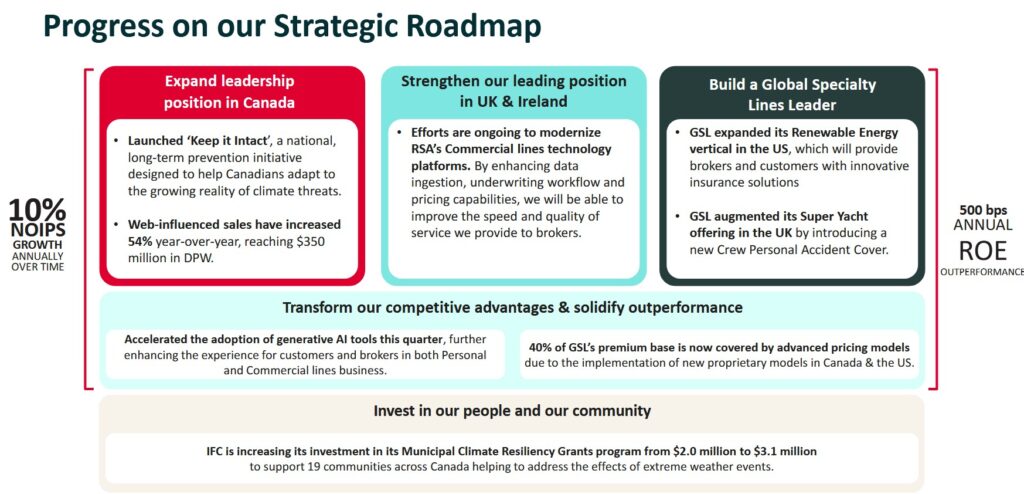
A good way to assess a company’s performance is to compare various annual metrics over a period of several years. The following (page 248 of 256) is from IFC’s FY2024 Annual Report. Pages 249 – 252 include additional metrics.
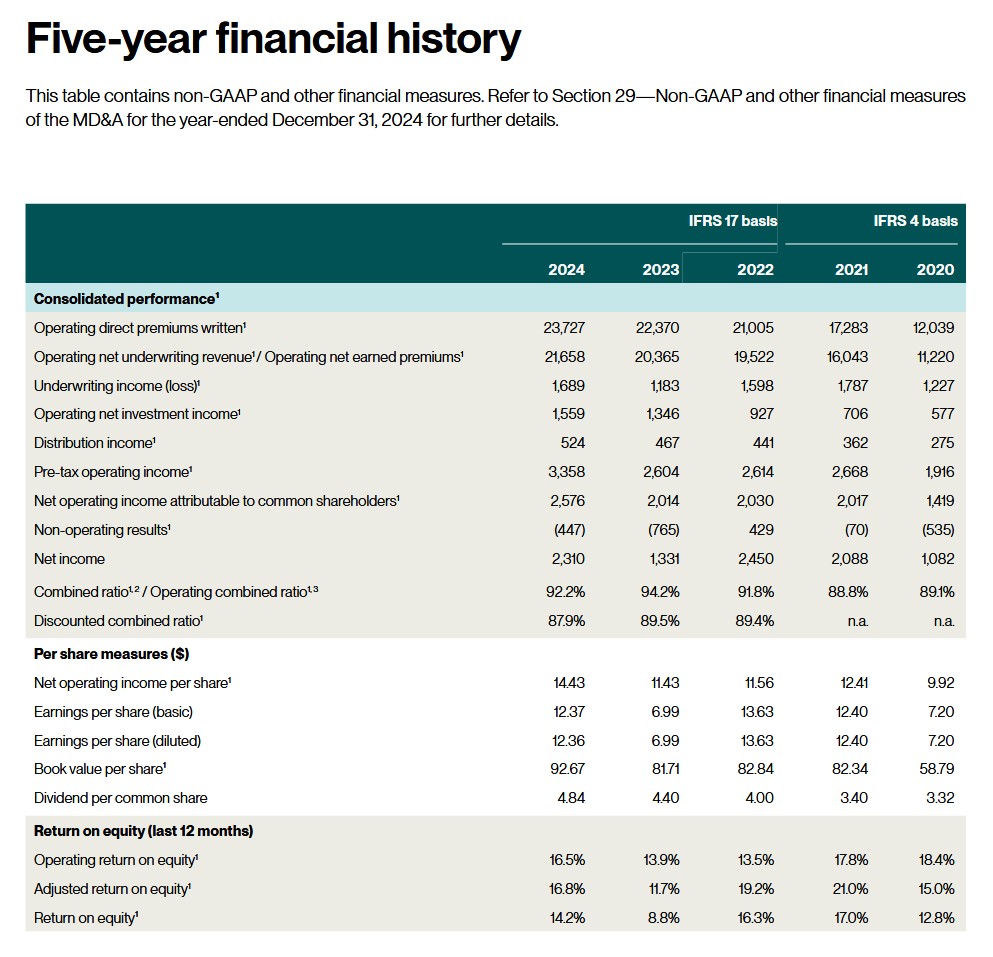
The following provides a snapshot of IFC’s consolidated performance over the 2018 – 2022 timeframe. This image is found on page 248 of 256 in IFC’s FY2022 Annual Report. Pages 249 – 251 include additional metrics.
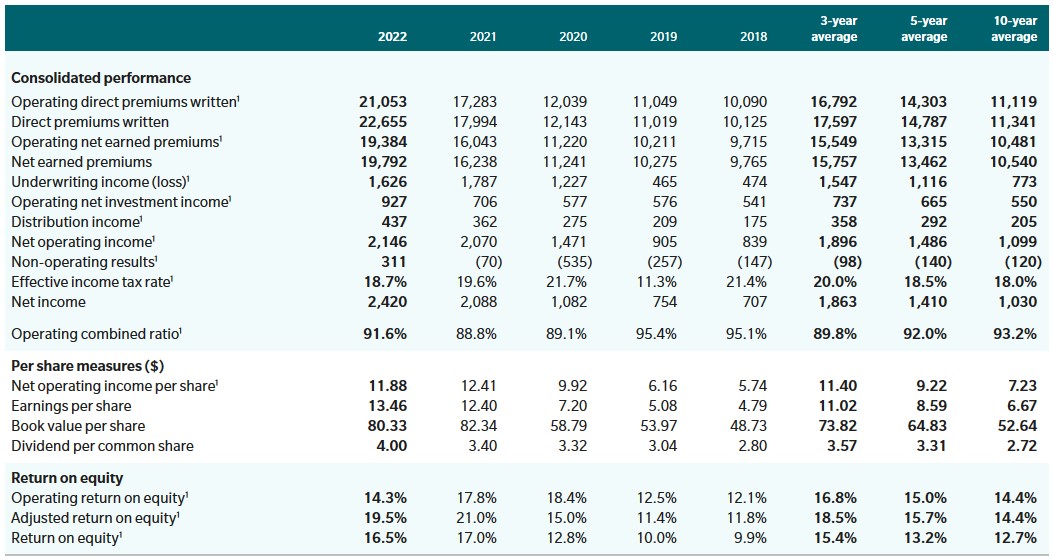
Financial Results
Q2 and YTD2025 Results
Information about IFC’s Q2 and YTD2025 performance is accessible through the Quarterly Results section of the company’s website. I provide the following, however, for ease of reference.

Capital Deployment
Several pages, commencing on page 122 of 147 in IFC’s May 21, 2025 Investor Day presentation, are devoted to the topic of capital deployment.

Underwriting Ratios
I pay particularly close attention an insurance company’s Operating Combined Ratio (OCR) track record.
This is a crucial metric in the insurance industry that measures an insurance company’s profitability and operational efficiency by comparing its claims and expenses to its earned premiums. It is the sum of the loss ratio (claims paid divided by earned premiums) and the expense ratio (operating expenses divided by earned premiums).
The OCR consists of 2 components:
- claims ratio
- expense ratio
The OCR is important because it is a Profitability Indicator. An OCR below 100% means the insurer is making an underwriting profit, paying out less in claims and expenses than it earns in premiums. A ratio above 100% means an underwriting loss, suggesting the insurer is paying out more than it receives from premiums. Even if above 100%, however, an insurer might still be profitable due to investment income, which is not included in this ratio.
It is also an indicator of an insurance company’s operational efficiency. It reflects how well the insurer controls claims costs and operating expenses. A lower ratio indicates better cost management and underwriting discipline, providing insight into the company’s operational effectiveness.
This metric is typically expressed as a percentage. It is a measure of profitability used by an insurance company to gauge how well it is performing in its daily operations. Many insurance companies believe that the combined ratio is the best way to measure success because it does not include investment income. It only includes profit earned through efficient management. This ratio is calculated by taking the sum of incurred losses and expenses and then dividing them by the earned premium.
IFC’s OCR is generally well below 100%.
Capital Structure
IFC has a proven and consistent capital management strategy. Management believes that its optimal financing structure is:
- 70% equity;
- 20% adjusted debt-to-total capital ratio; and
- ~10% is comprised of preferred shares and hybrid subordinated notes including Limited Recourse Capital Notes (LRCN).
For acquisition purposes and other special transactions, IFC allows for temporary increases in the adjusted debt-to-total capital ratio above its targeted level when it has good visibility on the company’s ability to return to 20% in the short to medium term.
The following reflects IFC’s capital structure at the end of Q2 2025.
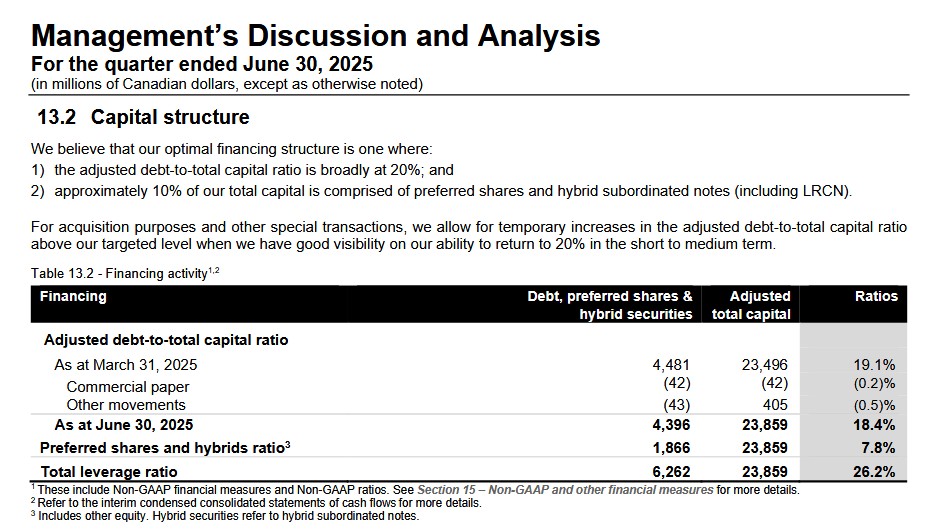
Looking at IFC’s senior and subordinated debt we see the maturity dates are well staggered.
Maintaining a strong capital position is a key priority. IFC’s capital ratios at the end of Q2 2025 are well above the Company Action Levels (CALs). The CALs are thresholds below which regulator notification is required together with a company action plan to restore capital levels. The average CAL for all regulated Canadian insurance entities is 169% MCT. The CAT varies by legal Canadian entities. The CAL is 200% RBC for regulated insurance entities in the US and 120% SCR for those in the UK & Ireland.
- MCT – Minimum capital test (Canada)
- SCR – Solvency Capital Requirement (Europe)
- RBC – Risk-based capital (US)
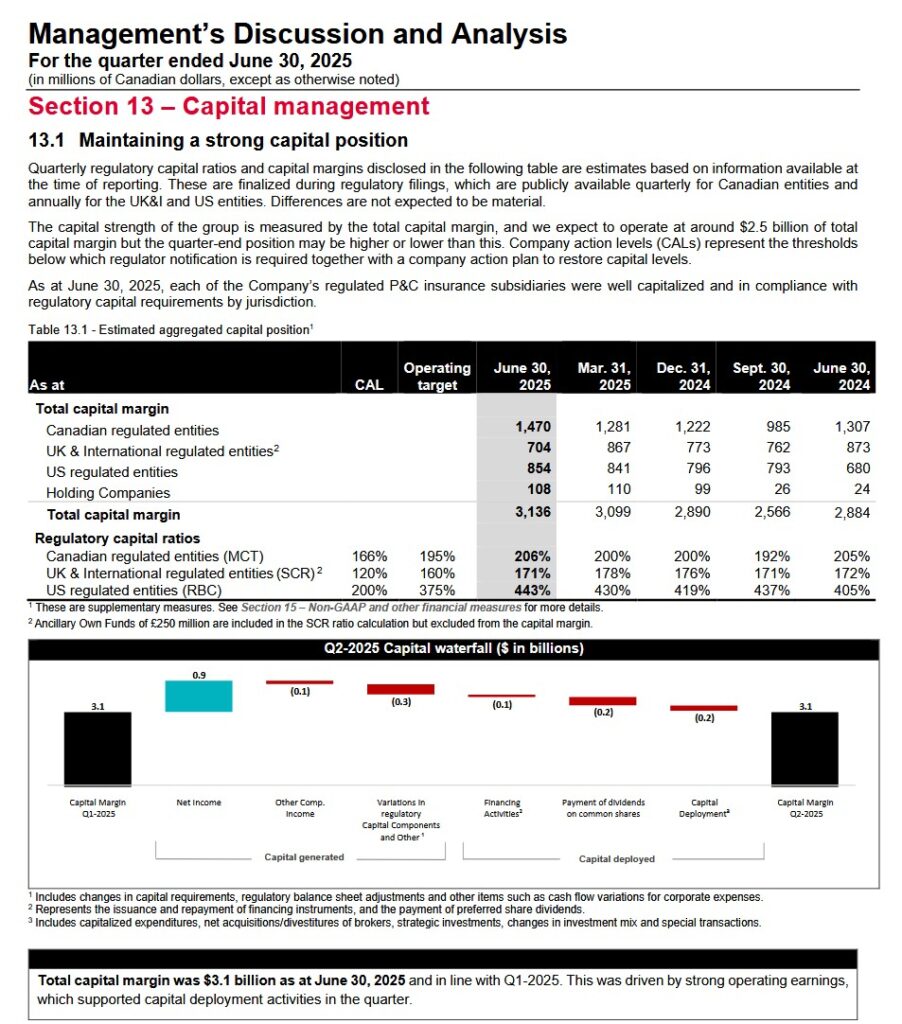
IFC – Strong Capital Position Q2 2024 – Q2 2025
Risk Assessment
The following table is a summary of IFC’s outstanding debt at the end of Q2 2025. IFC’s debt maturity schedule is well staggered.
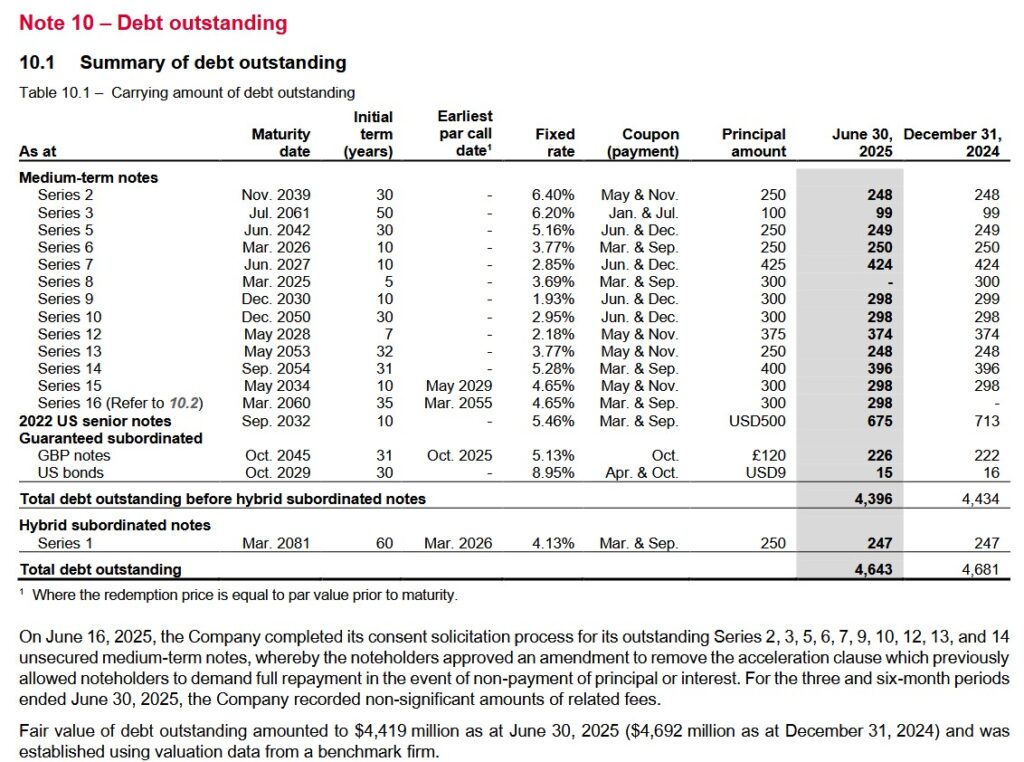

It is imperative that we not overlook the risk aspect of an investment. This is why I pay particularly close attention to the ratings and outlooks assigned by rating agencies.
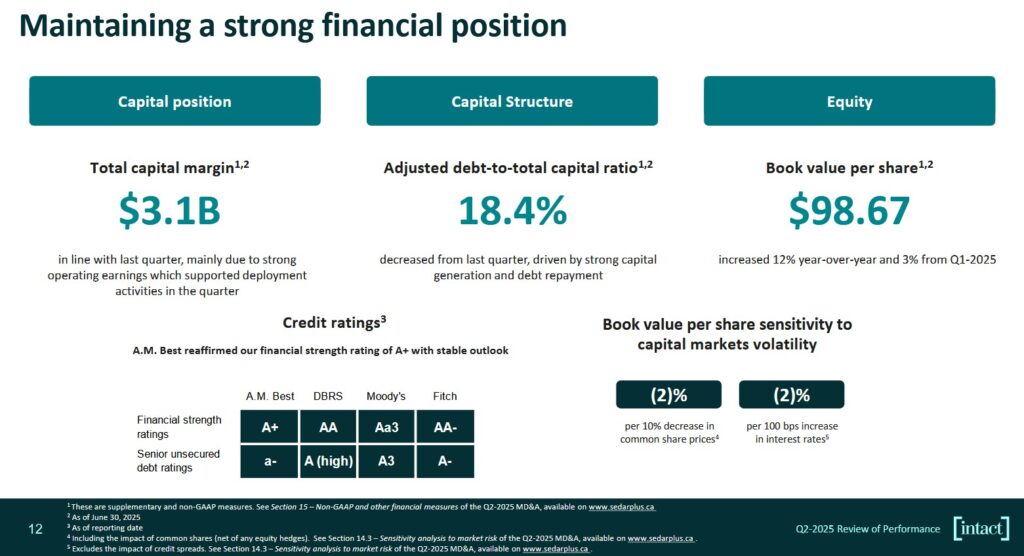
A more comprehensive list of IFC’s ratings and outlooks is accessible here.
I focus on the senior unsecured debt ratings assigned to Intact Financial Corporation because this is the publicly-traded company in which I hold shares.
The assigned ratings are all investment grade.
- DBRS’s rating is the top tier of the upper-medium grade investment-grade category. It is one tier higher than at the time of my prior review.
- Moody’s, A. M. Best’s, and Fitch’s rating is the bottom tier of the upper-medium grade investment-grade category. On October 8th 2024, Moody’s upgraded the financial strength rating of
IFC’s principal Canadian P&C insurance subsidiaries from A1 to Aa3 and its senior unsecured debt rating from Baa1 to A3.
All ratings define IFC as having a strong capacity to meet its financial commitments. It is, however, somewhat more susceptible to the adverse effects of changes in circumstances and economic conditions than obligors in higher-rated categories.
Dividend and Dividend Yield
Fixating on dividend metrics is a fundamentally flawed way by which to assess an investment opportunity. The focus should be on risk and total potential investment return. Nevertheless, IFC’s dividend history is accessible here if this is of interest to you.
As I compose this post, the dividend history section of the company’s website reflects the $1.21 December 31, 2024 dividend as being the most recent. IFC, however, has subsequently distributed a $1.33 dividend on March 31 and June 30.
IFC’s Board has approved the quarterly dividend of $1.33/common share payable on September 29, 2025 to shareholders of record on September 15, 2025.
IFC’s weighted-average number of common shares outstanding in FY2011 (in millions) was 115. It was 178.7 million in Q2 2205 and the first half of FY2025. The increase is primarily the result of IFC issuing shares over the recent years to fund acquisitions.

Valuation
When I completed my 2025 Mid-Year Portfolio Review I held a total of 524 IFC shares and the share price was ~$316.65. Coincidentally, the ~$317.35 52-week high was reached the same day. Fortunately, IFC’s share price has subsequently weakened and the share price is ~$291 as I compose this post.
I typically look at a company’s earnings, adjusted earnings, and free cash flow to gauge a company’s valuation. Free cash flow, however, is NOT a proper metric by which to evaluate an insurance company’s performance. This is because their cash flows and earnings dynamics differ significantly from typical operating businesses. Insurance companies have complexities that make projecting and using free cash flow less straightforward and less typical as a valuation or performance measure.
Using my ~$292.61 average purchase price on July 30, 2025 and the currently available forward-adjusted diluted EPS broker estimates, the forward-adjusted diluted PE levels are:
- FY2025 – 13 brokers – mean of $16.74 and low/high of $16.02 – $18.91. The forward adjusted diluted PE was ~17.5.
- FY2026 – 14 brokers – mean of $17.54 and low/high of $16.26 – $18.24. The forward adjusted diluted PE is ~16.7.
- FY2027 – 4 brokers – mean of $18.93 and low/high of $18.52 – $19.65. The forward adjusted diluted PE is ~15.5.
These earnings estimates are likely to be adjusted over the coming days. Furthermore, IFC’s share price may experience further weakness in the short-term. After some deliberation, I elected to add to my IFC exposure even though shares appear to be fairly valued/marginally overvalued.
Final Thoughts
When I last reviewed IFC in my June 2, 2023 post, I held a total of 515 shares. On July 30, I acquired 100 shares @ $292.36 in one ‘Core’ account (my average cost is now ~$187.80) and another 100 shares @ $292.85 (my average cost is now ~$191.83) in another ‘Core’ account in the FFJ Portfolio raising my exposure to 725 shares. The 10 additional shares were acquired through the automatic reinvestment of dividend income.
The following, extracted from IFC’s May 21, 2025 Investor Day presentation, reflects the extent to which IFC has rewarded shareholders over the past decade.

I have no idea if IFC can replicate this performance over the next decade. I am, however, prepared to wager that it can generate at least a 10% annual total shareholder return. At this rate and applying the Rule of 72, my IFC investment should double in 7.2 years. The average annual rate of inflation in Canada over the past decade is ~2.6%. Even if the average annual rate of inflation rises to 5% over the next decade, the appreciation in the value of my IFC investment is likely to more than offset my arbitrarily conservative inflation estimate.
I wish you much success on your journey to financial freedom!
Note: Please send any feedback, corrections, or questions to finfreejourney@gmail.com.
Disclosure: I am long IFC.
Disclaimer: I do not know your circumstances and do not provide individualized advice or recommendations. I encourage you to make investment decisions by conducting your research and due diligence. Consult your financial advisor about your specific situation.
I wrote this article myself and it expresses my own opinions. I do not receive compensation for it and have no business relationship with any company mentioned in this article.

